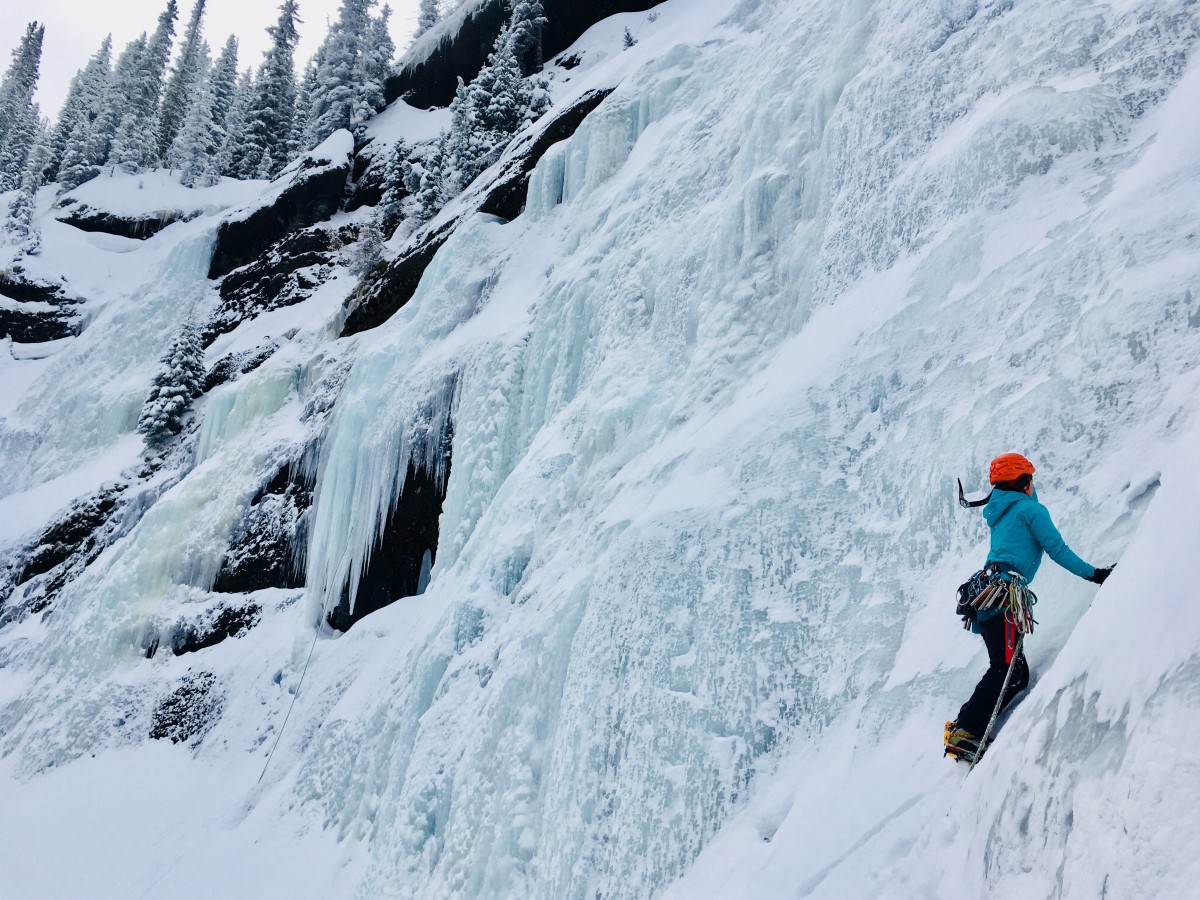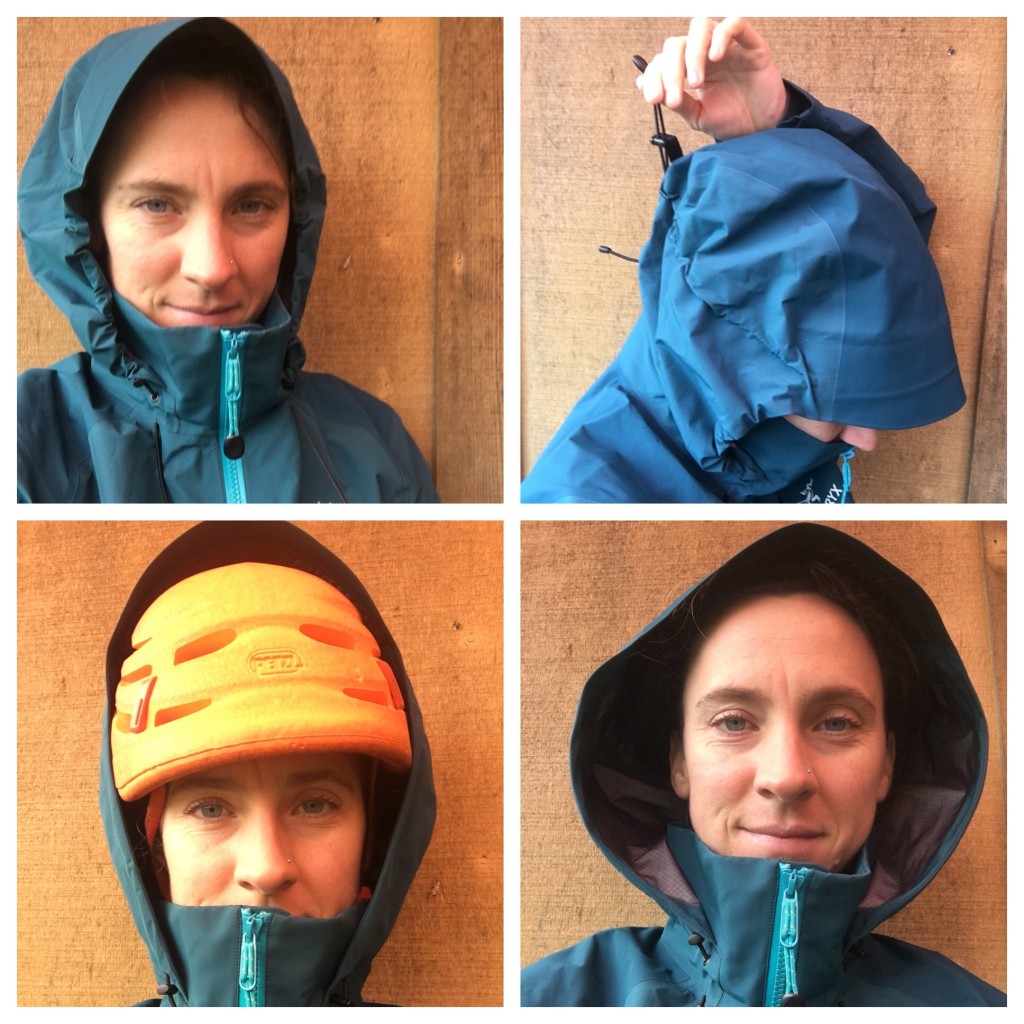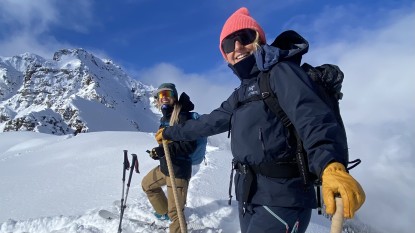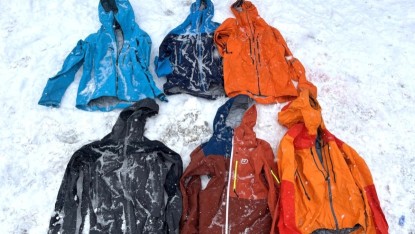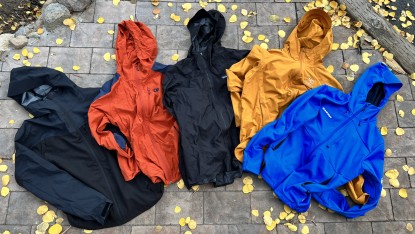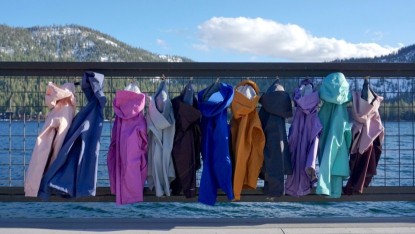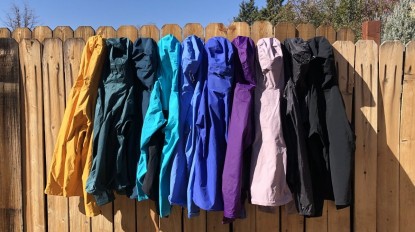A hardshell jacket can be a serious investment. These weatherproof garments are made of some technologically impressive fabrics and have a collection of carefully designed features to match certain outdoor pursuits. The plasticky, stiff materials need to be sewn together in a way that allows you to move freely. These important details add up to what can be a shockingly high price tag for a lightweight jacket. In this review, we've assembled some of the industry's leading models, with a broad assortment of styles — from burly use to fast and light models, and lots in between.
Before we dive into the details, let's examine one important question…
Should I Buy a Hardshell Jacket?
Depending on where you live, what you intend to use your jacket for, and how much you want to spend, it's important to consider why you need a hardshell in the first place. These jackets are built to keep you protected from the grossest weather that mother nature can throw your way. Wind, sleet, hail, and snow are no match…these jackets are meant to be bombproof. They are constructed with expensive breathable membranes designed to expel excess moisture (from sweating) while they repel the elements. In other words, these jackets should keep you dry from the outside and breathe well enough that you don't get wet from the inside — that's the grand irony in waterproof breathable technology.
In general, hardshells are tailored for alpinists who need protection in wetter and sloppier conditions. Not only that, but they should also be highly durable — a good jacket that is well cared for can last a decade or more! With all the good, there are a few deterring trade-offs. The biggest, and which is hard to digest, is the price. You end up paying for the extra durability and weather protection that you get. The fancy welded membranes that allow superior weather protection require special care to retain their integrity over the years. Even though the fabrics are more breathable than when hardshell jackets first made their appearance in the outdoor industry, they are still not as breathable as your classic rain jacket or, better yet, a softshell.
Alternatives to a Hardshell: Softshells and Rain Jackets
Now that you have an understanding of the pros and cons of a hardshell jacket, it's time to consider if you need to purchase one. If you are not planning to visit or travel in super wet and sloppy weather, consider an alternative shell that will provide you with more breathability at a lower price. Softshells and rain jackets offer some of the protection of hardshell jackets, without the higher level of durability and fancy fabrics (which remain weatherproof for a longer period).
Softshells have a flexible outer shell with a higher level of breathability. They tend to be a tiny bit heavier and provide decent wind resistance. You can layer them underneath or above an insulated jacket to provide a wind barrier. Although they are fairly wind resistant, they are not wind or waterproof. The fabric, if treated with a Durable Water Repellent (DWR) coating, will repel water for a short period before "wetting out." Their biggest plus is mobility. Mountain guides in areas like the San Juans in Colorado tend to use softshells versus hardshells because they can move more fluidly (softshells can be stretchier than hardshells). The weather is also drier in Colorado, producing snow that is light, in colder temperatures (well below freezing). However, if you were a guide in wetter climates, like the Washington State coast, for example, a hardshell would be your best friend. The snow there is heavy and wet, with temps much warmer — near freezing. Softshells wet out in no time in these conditions. To read more, check out our Best Softshell Jacket for Women Review.
Rain jackets are the best alternative to buying a hardshell jacket. Like their burly, more expensive cousins, rain jackets can protect you from wet, rainy weather, but they are typically composed of a more breathable fabric (the outer tends to be a lot thinner). They also pack down better and incorporate fewer fancy features. To top it off, they are less expensive, but you should not expect your rain jacket to last as long as a durable, high-quality hardshell jacket. You might find yourself in a rain jacket versus a hardshell if you are planning on long hikes, mountaineering, and skiing in drier climates, or if you're looking for a wind block on more aerobic days. To learn more, check out our review of the top women's rain jackets and our favorite women's budget rain jackets.
Now, if you are looking for something that will last longer than a softshell or rain jacket, and can hold up in the worst wet weather, then you'll want to consider purchasing a hardshell jacket. This mainly encompasses those in alpine environments where the weather changes quickly, and you need fantastic protection.
Types of Hardshell Jackets
Now that we've learned all about different types of fabrics and how they compared during our testing, it's time to talk about different types of hardshell jackets. Some come with a built-in liner, others have liners that can be zipped in and out, while others (like the ones in this review) have no liners at all. The idea behind these liner-less shells is that it gives you more freedom to choose your layers and use them when you please. Some of these shells might come equipped with a powder skirt and are ideal for skiing or snow activities. The products in this review are designed with a more ascent-oriented focus, so most do not have built-in liners, zip out liners, or powder skirts. Instead, they have features such as pockets that are positioned to accommodate wearing a harness or backpack that are more specialized for moving up the mountain. For your reading ease, we have divided the products in this review into three different categories.
Heavy Duty: These are best for extended robust trips, big mountain guides, or for those who work or spend a lot of time in the backcountry (multiple days at a time). These shells prioritize durability, which means they are a little heavier and pretty much bomb proof.
Medium: These are your all-purpose warriors. Built to take you to mountains and through the streets of rainy coastal cities. They tend to have fabrics that are more flexible and more breathable, along with a higher number of comfort features than the heavy-duty shells. Their durability is still high, and you'll have more mobility in a medium weight hardshell jacket than in one of the heavy-duty models. These will keep you protected from the elements when you're not looking for a severe weather rated shell.
Lightweight: These models are for the minimalist who is looking for a no-frills hardshell with few features and a super-lightweight design. They tend to be well under a pound, with incredibly breathable membranes and an affinity for protecting you from the elements. They are designed to help you move fast and pack down quickly. They also work as excellent wind shells on long missions and will keep you dry if the sky decides to cry. These lightweight models can get as light as 6-8 ounces.
Hardshell Construction
These jackets offer significantly more durability and weather protection than a softshell or even a rain jacket. With its heat-sealed seams and welded membranes, these layers are constructed with burliness in mind. To start, we will begin by examining the fabrics that make these jackets so magical.
How Do Breathable Fabrics Work?
Breathability in a fabric depends on three different factors. The first is the size of the pores in the membrane. The pores are not big enough to allow water molecules or wind inside, but they are large enough to let moisture vapor to pass through; with your body heat pumping, this pushes sweat outside of the jacket. The second factor is the number of pores for a given area. The higher the number of pores, the more breathable the fabric and vice versa. The third factor is the type of polymer used. GORE-TEX, for example, uses a rigid polymer while other less rigid (more mobile) fabrics use hydrophobic (hydo=water, phobic = repelling) molecules to keep the water out, and allow the air to pass through. Throughout our testing, we found that different fabrics had different functions due to the differences in these three factors.
Functional Fabrics
Waterproof breathable fabrics have evolved tremendously over the decades, and even over the years, this review has been in publication. Nearly all of the jackets in this review utilize one of the GORE-TEX products, with a few still using a proprietary waterproof breathable membrane, which can be inferior. Here, we discuss the various fabrics from GORE-TEX that you will find in our fleet.
GORE-TEX Varieties
In 1969, Bob Gore (son of the founding Bill and Vieve Gore) discovered a polymer that would later be integrated into hardshell jackets in 1976. Polytetrafluoroethylene (ePTFE), used in Gore-Tex shells, is a rigid polymer that repels water and oxygen molecules and allows water vapor molecules to pass through its membrane allowing for ample breathability and weatherproofing. Today, Gore-Tex is still the leading producer of breathable fabrics used in hardshells. Brands like Arc'teryx, Patagonia, and Outdoor Research are just a few companies (of the many) that integrate GORE-TEX into their garments. The company also offers a variety of different types of weatherproofing for different functions. Take a look below at the various levels found used in this review.
GORE-TEX Pro (Extended and Extreme Conditions): This three-layer material is made of face fabric, membrane, and liner, which are all welded together. It is designed to be extremely rugged, breathable, and versatile.
Best Uses: Any conditions requiring superior weather protection like long extended mountaineering trips, nasty and wet weather situations, or highly abrasive trips that need a rugged shell.
GORE-TEX Active (Lightweight and Aerobic Activities): This material also uses three-layer technology but prioritizes breathability, lightweight, and minimalist design over other attributes.
Best Uses: Any aerobic activity (i.e., backcountry skiing, cross-country skiing, snowshoeing), light wear around town uses.
GORE-TEX Paclite Plus (Ultralight and Breathable): This is technically a 2-layer fabric, but it holds up to an impressive array of mountain adventures in milder climates.
Best Uses: Aerobic activities in poor weather, in all but the more extreme mountain environments.
GORE-TEX ShakeDry (Fast-and-Light Elite Wear): This is the most breathable waterproof product from Gore. Water droplets just bead up and shake off.
Best Uses: Running in wet weather or to bring along as a waterproof wind shirt for emergencies on routes where every ounce counts and the weather looks decent, but you want a shell just in case.
Other Fabrics
Patagonia uses its proprietary H2No fabric, which is comparable, though nothing quite approaches the Gore legacy, in our experience.
The Make-Up Of A Shell Membrane
Different types of textile technology use different membranes, which allows for various levels of performance. In each membrane, several molecules work together to create an active transport system that effectively moves moisture away from the body and out into the environment. For example, GORE-TEX utilizes a polymer called polytetrafluoroethylene (ePTFE) that is non-toxic, biocompatible, non-soluble, and water repellant. It is very porous with a rigid structure that allows air to move through the fabrics (for breathability) but still keeps water out. Pore size and quantity in different types of jacket materials is a big reason why some shells may be more breathable than others. Check out this video to learn about air permeability with varying types of membranes and how different fabrics performed.
Any fabric that utilizes ePTFE (because of its continuous structure) will also be more rigid due to the continuous formation of the ePTFE molecule. There are other fabrics out there, utilizing different polymers or materials that make the fabrics more flexible. While this is highly weatherproof, these fabrics tend to be pretty rigid with less mobility due to the "continuous" structure of the ePTFE. Some materials will utilize other polymers like eVent technology. They forgo the use of the ePTFE and use a high performing Polyurethane or Polyester membrane instead. This is thinner with more stretch. This creates a similar amount of weather protection but without the rigidity of a typical shell.
Membrane Layers: How many layers do you need?
Membranes come in many different types and price ranges. A good shell jacket will utilize either a 2, 2.5, or 3 layer fabric design. So which do you choose? More layers equal more weather protection and durability, and sometimes less weight.
Many outdoor recreationalists will be just fine with a 2.5 layer shell, often considered a rain shell. They provide ample weather protection and are functional whether you are on your favorite day hike, climbing a small mountain in the Adirondacks, or simply going out to the ski hill on a lovely spring day.
Three-layer shells are only really necessary if you're preparing for some of the worst, wet weather that you have been through. So don't go blowing your next paycheck on a three-layer shell when all you need is two or 2.5-layer one.
Gore-Tex Paclite is considered a 2-layer jacket but still performs as a hardshell — it's just incredibly lightweight and consequently less durable.
Heat-Sealed Seams
To add to the fabric's weatherproofing, all seams on are "heat-sealed" so that any holes created from stitching will not become a weak point allowing water inside at any time. Just another reason why hardshells are great at keeping the elements out.
Stand Out Features
Hardshell jackets come with a plethora of features to keep you safe when mother nature throws you a curveball. Below, we outline what to look for on the hood, hem, and pockets to stay dry and comfortable in even the worst conditions.
Adjustable Hoods
All of these jackets will have an adjustable hood. If you are going to do anything with big fat gloves on, look for a hood that is helmet-compatible (all jackets reviewed here are), has a pull tab large enough to work with your gloves, and has adjustment systems that allow you to tighten or loosen with one pull.
Wrist Closures
Wrist closures are important for keeping out snow, wind, and other elements that will leave you cold when you're hunkered in at a cold, icy belay. Look for wrist closures that are thick (longer durability) and have enough Velcro to wrap around your whole wrist. This is important when fitting full-length gloves over top or if you need to open them up to fit them underneath.
Pockets
Pockets are of huge importance if you are going out on a long mission or if you're just hanging out in the Ouray Ice Park. It's important that they are deep enough to fit your essentials (i.e., energy bar, phone, money, etc.), and positioned properly to ensure that you can do the things that you love. For a climbing shell, pockets should be high enough to access above a harness or backpack waist belt. Another bonus is having a chest and/or interior pocket to store things for easy access.
High Collar
It's of utmost importance that your shell has a high and roomy collar to accommodate nuzzling down when the weather turns bad. It keeps your face warmer and helps to avoid frostnip if it's frigid outside. Look for microsuede on the inside collar - this will keep your skin a little less sensitive with the elements. If you try on a jacket and you can't nuzzle in, consider if it's the best fit for you.
Ways to Wear your Hardshell Jacket
When most folks think of how to wear a shell, they tend to assume that it always goes on top. Though, there is another option for different activities and situations.
- Wearing your insulated jacket over top of your shell: When the weather isn't bad, and you're trying to mitigate the amount of heat that you're generating, this is an excellent method to utilize. Just wear your insulated jacket over top of your shell in between bouts of activity. For example, in alpine climbing, when it's your turn to swing the ice tools, stash your insulated jacket. When it's time to belay, put it back on for warmth. The shell stays on to keep the wind and water out at all times.
- Wearing your insulated jacket underneath your shell: Optimal for nasty, wet, and bitterly cold conditions. Keep the warmth inside your jacket and all the elements off of you.
Tips to Revive and Renew Your DWR Finish
Even though these jackets will take the brunt of it all, they need to be cared for to maintain weather protection as the years go on. There are a few simple tips for you to do just that.
Test To See If Your DWR Has Worn OffTake a few water droplets and gently sprinkle them onto the fabric. Do the water droplets bead up? If so, your DWR coating is okay. If your water droplets don't bead up but instead sit on the fabric and make their way into the fibers, then your DWR needs to be brought back from the dead.
Clean ItA clean jacket is the first step to reviving your DWR. Follow the washing instructions on the label, making sure to avoid heavy-duty laundry detergents.
Apply Heat
When you expose your garment to just a little bit of heat, it can help coax your DWR back to life. Simply throw your jacket into the dryer for 10 to 15 minutes on low to medium heat.
Reapplying Your DWR FinishSo you've taken all the steps above, and your jacket is still wetted when you apply water to it. Then it is time to reapply the DWR treatment; this will eventually happen as you expose your jacket to natural wear and tear in the outdoors and just around town. So what do you do? You need to go out and buy a DWR revival product such as Nikwax or Granger's. Follow the instructions, and you will be on your way to a new water-resistant coating!

